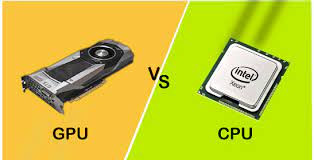CPU (Central Processing Unit) and GPU (Graphics Processing Unit) are both types of processors, but they are designed for different types of computational tasks. Here’s the difference between CPU and GPU:
CPU:
- General-Purpose Processor: CPUs are general-purpose processors that are designed to handle a wide range of tasks efficiently. They are responsible for executing instructions and managing the overall operation of a computer system.
- Serial Processing: CPUs excel at sequential processing, where tasks are executed one after another. They are optimized for tasks that require high single-threaded performance, such as running operating systems, web browsing, database management, and general-purpose computing.
- Multitasking: CPUs are designed to handle multiple tasks simultaneously through techniques like time-sharing and multiprocessing. They have a few powerful cores (typically up to a few dozen) to handle complex tasks efficiently.
- Control Flow: CPUs are responsible for managing the control flow of a program, making decisions, and executing instructions based on the program’s logic.
- Versatility: CPUs are highly versatile and can perform a wide range of tasks, including complex calculations, data manipulation, and running various software applications.
GPU:
- Parallel Processing: GPUs are specialized processors designed for parallel processing. They excel at performing multiple computations simultaneously, making them highly efficient for tasks that can be broken down into many smaller, independent calculations.
- Graphics Rendering: GPUs were originally designed for rendering graphics in video games and other visual applications. They have thousands of smaller, less powerful cores compared to CPUs, allowing them to handle parallel tasks efficiently.
- Data Parallelism: GPUs are particularly effective at tasks that can be parallelized, such as image processing, video encoding/decoding, scientific simulations, machine learning, and cryptocurrency mining.
- Floating-Point Operations: GPUs have a high number of cores optimized for floating-point operations, which are commonly used in graphics rendering and scientific computations.
- Memory Bandwidth: GPUs have high memory bandwidth to efficiently handle large amounts of data required for parallel processing tasks.
In terms of raw computational power, GPUs are generally more powerful than CPUs when it comes to parallelizable tasks. They can perform massive parallel computations much faster than CPUs. However, CPUs excel at handling complex tasks that require sequential processing, decision-making, and running a wide range of applications.
It’s important to note that the strength of a CPU or GPU depends on the specific model, architecture, and intended use case. The choice between CPU and GPU depends on the type of workload or task you need to perform. Some tasks may benefit more from the CPU’s single-threaded performance and versatility, while others may leverage the GPU’s parallel processing capabilities for significant performance gains.
